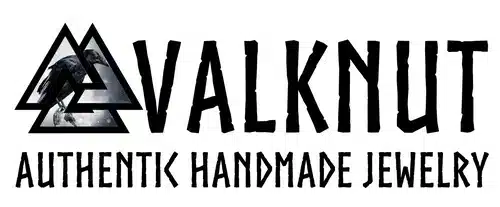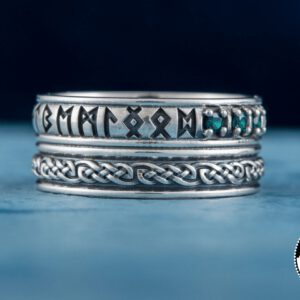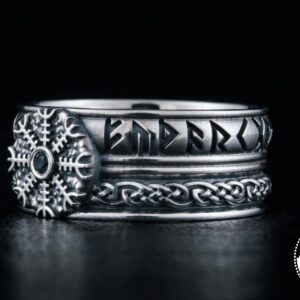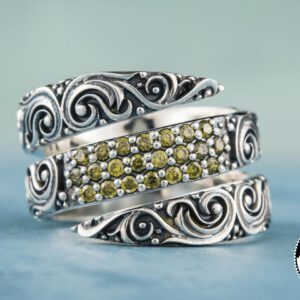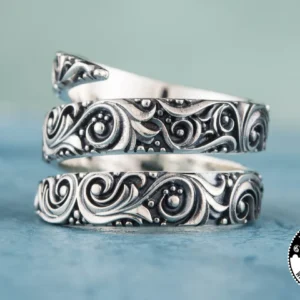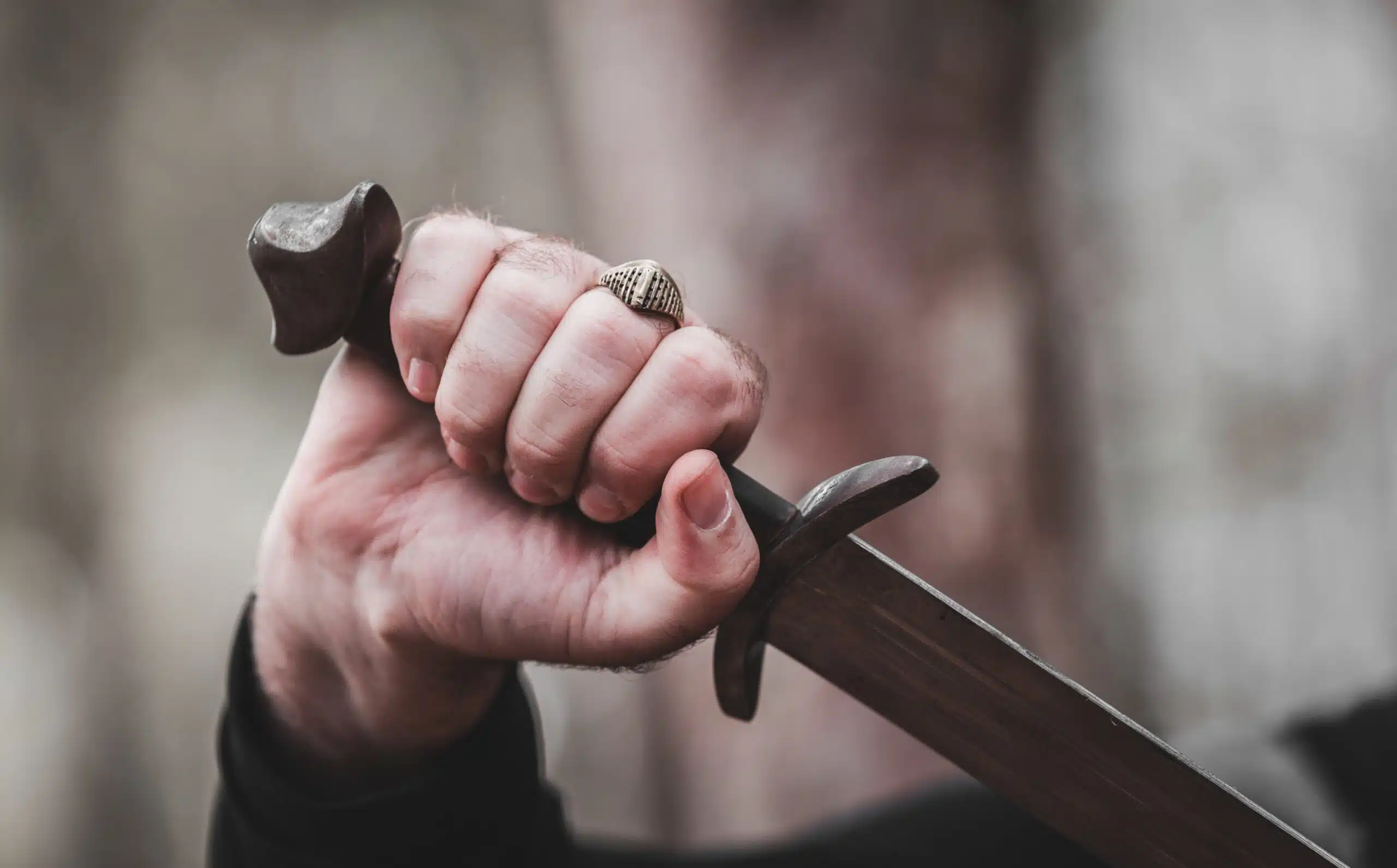Ancient Viking jewelry is highly desirable and collectible, as this intricately designed jewelry from the Viking era carries a great deal of cultural, historical, and social significance.
With ancient Viking jewelry for sale, jewelry collectors have the opportunity to own a piece of history.
Ancient Viking jewelry incorporates a variety of intricate designs, each featuring its own unique symbolism.
Viking motifs such as the sun wheel and the fire dragon give information about the Viking era lifestyle, beliefs, and heritage.
Today, ancient Viking jewelry is highly sought after and desirable due to its woven stories and remarkable craftsmanship.
Some of the most notable pieces of Viking jewelry include brooches, necklaces, rings, and arm rings, each of which is a reminder of a bygone era.
As a result, ancient Viking jewelry for sale is a perfect choice for enthusiastic collectors, conveying a specific era’s context and culture.
Join Our Viking Journey
Never miss a beat on the latest Viking jewelry trends, exclusive offers, and exciting updates. Subscribe to our newsletter and be part of our vibrant community.
Unique Styles and Designs
A feature that truly sets apart the Viking jewelry designs is their use of interlacing patterns, often intertwined with flowing shapes and designs.
The Vikings discovered a way to combine metal threads in the shape of a knot that could further be embellished with delicate designs.
This practice of interlacing was a way for the Vikings to bring together materials and fashion pieces that held a greater symbolic meaning.
The technique has been used to create show-stopping necklaces, rings, amulets, and brooches that often take the form of animals, plants, and abstract designs.
The Vikings were also skilled in the craft of metalwork which can be seen in many of their pieces.
Their pieces often made use of forging and hammering, which allowed the Vikings to meticulously shape metal details like the faces of animals or figures.
In some cases, the Vikings even used the casting technique, pouring molten metal into a pre-made mold to create incredibly detailed works of art.
Moreover, some pieces feature beading and filigree, a hallmark of Viking jewelry.
These ornate details are composed of round or oval balls connected by thin strips or wires with the same pattern or theme.
As it is now, Vikings used their intricate beading to adorn their accessories and often centered them around one unified design motif.
This allowed for more valuable collections due to its coherent aesthetic concept.
By combining different materials and techniques, the Vikings created unique pieces which still stand out today.
With their craftsmanship and the deep symbolism of their designs, it is no wonder why many people are so passionate about ancient Viking jewelry.
-
Sale!
Norse Poetry and Runes Ring, 925 Sterling Silver
$79Original price was: $79.$25Current price is: $25. Select options This product has multiple variants. The options may be chosen on the product page -
Sale!
Helm of Awe and Runes Ring with Cubic Zirconia, Sterling Silver
$79Original price was: $79.$25Current price is: $25. Select options This product has multiple variants. The options may be chosen on the product page -
Norse Snake Ring with Gems, 925 Sterling Silver
$109 Select options This product has multiple variants. The options may be chosen on the product page -
Norse Snake Ring, 925 Sterling Silver
$89 Select options This product has multiple variants. The options may be chosen on the product page
-
Sale!
Norse Poetry and Runes Ring, 925 Sterling Silver
$79Original price was: $79.$25Current price is: $25. Select options This product has multiple variants. The options may be chosen on the product page -
Sale!
Helm of Awe and Runes Ring with Cubic Zirconia, Sterling Silver
$79Original price was: $79.$25Current price is: $25. Select options This product has multiple variants. The options may be chosen on the product page -
Norse Snake Ring with Gems, 925 Sterling Silver
$109 Select options This product has multiple variants. The options may be chosen on the product page
Symbolic Representations Found in Viking Jewelry
Viking jewelry was more than just a materialistic item- it served many symbolic functions for its owners.
Many pieces of Viking jewelry had significant meanings, as religious symbols, indicators of wealth, protection against danger, and more.
Norse gods and goddesses, such as Odin and Tyr, held a very central place in Viking culture, and as such symbols representing these deities were commonly seen in Viking jewelry.
Consumers of Viking jewelry often associated themselves with the power of these gods or hoped that the jewelry would help them in life by seeking favor with the gods.
Additionally, chief symbols of the Viking culture, such as the hammer and the Mjolnir, a hammer with a magic spell cast upon it, were often used as worn as pendants or charms.
Wealth also plays a role in many of the symbolic representations in Viking jewelry. While it was not completely uncommon, it was relatively rare to find a single piece of jewelry made entirely of silver or gold.
The most common form of precious metal seen in Viking jewelry is alloyed metals, meaning other metals were mixed with gold or silver to give them a more decorative sheen.
Therefore, these alloyed metals represented an indicator of wealth among Vikings, who could only be afforded these alloyed metals due to their higher economic status.
The tree of life, a symbol associated with water, Earth, and life energy, was another common symbol in Viking jewelry.
Despite being different than the otherwise predominantly warrior-related symbols, the tree of life was thought to have magical powers and tie a person’s spiritual energy to the life energy of the universe.
Animal and bird figures also made frequently made appearances in Viking jewelry, often as charms in the form of frogs, turtles, and birds.
In Norse mythology, these animals were thought to possess greatness and power, namely that they granted humans good luck and protection.
Viking jewelry pieces were often symbols of protection and wards against harm.
Knots were used in Viking culture to ward off spells and symbolized the binding together of body and spirit.
The Norse tradition of using knots was almost always an intention of tying oneself to divine or holy power, god, or goddess.
Runes also served to boost the protective functions of jewelry.
Runes were used often in Viking jewelry to increase the wearer’s luck and to ward off misfortune and evil spirits.
In some cases, forge engraving of runes was more than just decoration and included a species of magical practice, known as Seidr in the Norse tradition.
It is clear that many of the symbolic representations found in Viking jewelry are woven into important symbolic strands of Viking culture.
As a collector of Viking jewelry, you will find that many of them possess power and myths dating back to their original owners and creators.
Each of these symbols offers an interesting glimpse of the beliefs, myths, and practices the Vikings held dear.
Rich Variety of Styles and Designs
One of the most popular styles of Viking jewelry is seen in the magnificent warrior bracelets.
These arm rings symbolized strength and bravery and were only worn by Viking warriors or royalty.
Typically crafted out of gold or silver, they often featured intricate knotwork designs and sometimes had carved semi-precious stones at the center.
Another extremely popular style of Viking jewelry is the great neckpieces.
Referred to as torque or torq necklaces, these were typically created using intertwining metal wire or intricately engraved metal plates.
They were often formed when the person gifted the necklace placed their hands around the recipient’s neck, symbolizing their love and bond.
Usually made from gold or silver, torques could also feature precious stones inlaid in the metal design.
The well-known Norse animal ornamentation is another distinct style of Viking jewelry.
This design consists of wild animals, monsters, stylized runes, and symbols.
Adorning oneself with these figures was believed to bring strength, protection, and power.
These animal ornaments were crafted out of silver or gold metal and could feature a variety of semi-precious stones.
A fourth style of Viking jewelry can be seen in the excellent brooches.
Popular both in the Viking age and in modern times, these elaborate metal pins were often used to close cloaks or garments together. Crafted out of metal, these brooches often featured intricate knotwork and animal ornamentation designs.
The most iconic example of a Viking brooch is the popular “thistle brooch,” which features a beautiful slab of mother-of-pearl at the center.
More Articles
Exploring the Ancient Viking Meaning of the Valknut Symbol
What Makes Ancient Viking Jewelry so Collectible and Desirable?
Facts and FAQs About Viking Jewelry that You Should Know
Exploring the Ancient Viking Meaning of the Valknut Symbol
What Makes Ancient Viking Jewelry so Collectible and Desirable?
Facts and FAQs About Viking Jewelry that You Should Know
Role in Cultural and Social Events
The role of ancient Viking jewelry in cultural and social events was incredibly important. In Scandinavian cultures, jewelry was seen as a representation of wealth, power, and status.
This meant that those who could afford to wear jewelry associated with their culture were respected and seen as more successful.
As a result, ancient Viking jewelry was often gifted during special occasions such as weddings, birthdays, and other milestones, as it was seen as a valuable asset.
Vikings often wore symbols and designs of their gods and goddesses in their jewelry, an important expression of their culture and beliefs.
Cultural symbols such as jasper beads or Mjölnir, the hammer of Thor, were often integrated into their jewelry designs to make them more meaningful and special.
Additionally, jewelry was worn to battle by warriors to give themselves courage and protection.
In most ancient Viking societies, their jewelry was seen as so precious that some people were even buried with it, indicating its significance and role in the culture.
It was also used as a symbol of love, as many couples gave each other expensive jewelry.
This jewelry was often engraved with tiny messages or meaningful symbols, which were used to express love, affection, and admiration.
Moreover, jewelry was often given to young adults as a reward for their good behavior or achievements, as it was seen as a powerful symbol of success.
For example, a young Viking male may receive a gold bracelet upon reaching the age of adulthood, and a young Viking woman may receive a necklace as recognition for her good deed.
This demonstrated the importance of Viking jewelry in cultural events and traditions.
-
Sale!
Norse Poetry and Runes Ring, 925 Sterling Silver
$79Original price was: $79.$25Current price is: $25. Select options This product has multiple variants. The options may be chosen on the product page -
Sale!
Helm of Awe and Runes Ring with Cubic Zirconia, Sterling Silver
$79Original price was: $79.$25Current price is: $25. Select options This product has multiple variants. The options may be chosen on the product page -
Norse Snake Ring with Gems, 925 Sterling Silver
$109 Select options This product has multiple variants. The options may be chosen on the product page -
Norse Snake Ring, 925 Sterling Silver
$89 Select options This product has multiple variants. The options may be chosen on the product page
-
Sale!
Norse Poetry and Runes Ring, 925 Sterling Silver
$79Original price was: $79.$25Current price is: $25. Select options This product has multiple variants. The options may be chosen on the product page -
Sale!
Helm of Awe and Runes Ring with Cubic Zirconia, Sterling Silver
$79Original price was: $79.$25Current price is: $25. Select options This product has multiple variants. The options may be chosen on the product page -
Norse Snake Ring with Gems, 925 Sterling Silver
$109 Select options This product has multiple variants. The options may be chosen on the product page
Modern Appeal of Viking Jewelry Made Today
The modern appeal of Viking jewelry made today has only strengthened in the years since its introduction to the world.
Viking jewelry offers a unique range of playful and bold designs that reflect a range of influences.
From edgy and tribal rings to exquisite Chieftain-style armbands and stunning pendants, there is something to appeal to a wide array of tastes.
The Viking style is unrivaled when it comes to bold and daring expressions.
Each piece is elaborately and exquisitely crafted, showcasing intricate etchings, bold shapes, and dazzling color combinations that create a show-stopping look.
Many modern Viking jewelry pieces also come with interesting design details like special closures, secret compartments, and even images from pagan mythology.
Today’s Viking jewelry comes with a range of finishes and materials. Many pieces are crafted in luxurious gold and silver, but others are made from unusual materials like bronze, pewter, and even naturally-sourced gemstones.
In addition to the luxurious metals and stones, many pieces are adorned with intricate artisan-created texture work, creating a truly unique look.
The timeless quality of Viking jewelry has been a strong part of its modern appeal. Pieces like Thor’s hammer often feature in various trends, and chieftain armbands have become iconic.
As such, Viking jewelry appeals to those who want to make a statement and are looking for something traditional yet still utterly unique.
The mystical symbol and connotations associated with Viking jewelry add to its modern popularity.
However, it’s not just about making a fashion statement; Viking jewelry owners can feel as though they are part of a long, illustrious tradition, connecting them to the storied history of the Viking culture.
Finally, the affordable cost of modern Viking jewelry plays a role in its continued popularity.
While many antique pieces cost a fortune, modern Viking replicas and updated versions are much more affordable and accessible. As such, anyone can add a touch of Valhalla to their wardrobe.
